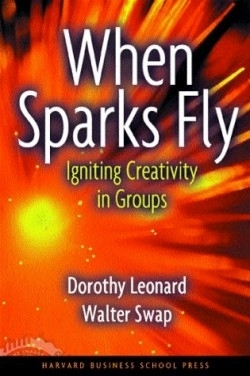
When Sparks Fly
Igniting Creativity in Groups
This book focuses on the manager’s perspective. While most books on creative thinking are aimed at the individual, providing techniques on how to think “out of the box” to be a more creative problem solver, When Sparks Fly takes many of those same techniques and shows how to apply them to groups. Harvard Business School professor Leonard and Dean of Colleges at Tufts University Swap contend that a well-managed group tends to make better decisions faster than those made by individuals.
The authors tie together two perspectives: basic research in psychology and practical experience in management. Their five-step process starts with the importance of diversity to creative thinking and understanding the role different races, genders and cultural and educational backgrounds play in reaching creative solutions. Forming a group, however, with diverse people to solve a problem won’t work if management then stifles their creative power. Leonard and Swap use the term “creative abrasion” to describe bringing people together and establishing ground rules to help them interact profitably. Other key concepts are the use of “divergent thinking,” or giving the team wide latitude in generating the widest variety of solutions to a challenge, followed by a period of “incubation” that allows the team to think about their ideas.
The authors also include ideas on how to set boundaries and goals for a solution that is consistent with the company’s need and vision without unnecessarily limiting options. Leonard and Swap conclude with a discussion of the role the environment plays in group creativity and discuss the vital concept of “failing forward,” or learning from and making sure the organization benefits from failures.
When Sparks Fly combines strategies and techniques from a wide variety of sources with a new spin on managing the creative process in a group organizational setting. Numerous examples, from such well-known companies as Fisher-Price, Hewlett-Packard, Xerox, MTV and Proctor and Gamble are used to illustrate successful implementation of these concepts as well as those that illustrate what to do when things don’t work as planned.
Written in quick paced prose, this book will ignite sparks for management teams looking to light the creative fire.
Reviewed by
Vicki Gervickas
Disclosure: This article is not an endorsement, but a review. The publisher of this book provided free copies of the book to have their book reviewed by a professional reviewer. No fee was paid by the publisher for this review. Foreword Reviews only recommends books that we love. Foreword Magazine, Inc. is disclosing this in accordance with the Federal Trade Commission’s 16 CFR, Part 255.
